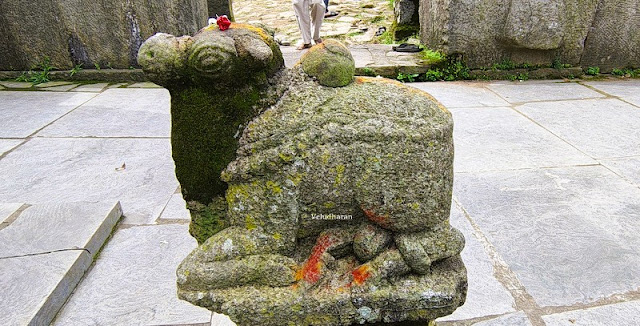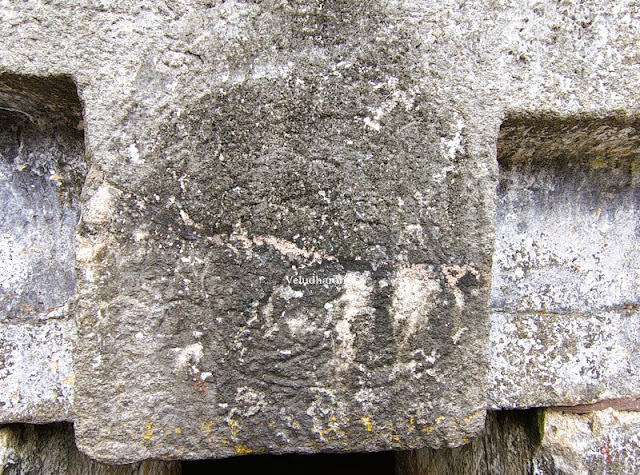The visit to this Sri Yudhistar
Temple at Mahendragiri, Odisha was a part of the “Kalinga and Ottara Desa Heritage
Walk” organised by சோழ மண்டல வரலாற்றுத் தேடல் குழு, between 13th to 18th September 2024. The purpose of this Heritage walk was to see the places,
monuments, etc., which are directly or indirectly connected as proof of
Rajendra Chozha’s victory mentioned in his meikeerthi/title over Kalinga and
Ottara Desa, the present Andhra Pradesh and Odisha.
This Yudhistar temple is one
of the Shiva temples built during the 10th to 11th Century,
in Ottara Desam, presently called Odisha State. There was no proper road to
access this temple till the 20th Century. Road forming and widening
works are in progress by the Odisha Government as a part of Tourism
Development.
The temple faces west, on the
west side of the road which leads to Kunti Temple. The temple only with a
Sanctum sanctorum. The Sanctum sanctorum is about 4 feet below the ground level
and the Shiva Lingam is at the centre. A Rishabam is in front of the Sanctum
Sanctorum. Parivara sannidhi’s are in
front of the temple without any images.
ARCHITECTURE
This temple consists of a
rekha deula and a rectangular enclosure wall constructed of granite stones,
dedicated to Lord Shiva the temple faces west and rises from the ground
level on the Tri-Ratha plan. On elevation, the temple is comprised of pabhaga, jangh
gandi, and mastaka. The bada/gabhaga consists of three moldings (jagathy,
vrudha Kumudam, and Pattikai ), while the jangha is plain. The gandi has fourteen
mouldings decorated with semi-circular design and tapering upwards supporting
the crowning amalaka. A large vajra mastaka is depicted on the rahapaga of the
gandi on the western side. The exterior part of the temple is devoid of any
sculptural decoration except the Chaitya arches on Rekha paga stylistically.
HISTORY AND
INSCRIPTIONS
The temple may be datable to circa 8th
Century CE by Somavamsi Kings. The meikeerthi of Rajendra Chozha records the
victory over the Bengal, the northern part of India, in a war. The meikeerthi goes
like this…..
ஸ்வஸ்திஸ்ரீ
திருமன்னி வளர இருநில மடந்தையும்
போர்செயப் பாவையும் சீர்தனிச் செல்வியும்
தன்பெருந் தேவியர் ஆகி இன்புற
நெடிதியல் ஊழியுள் இடதுறை நாடும்
…….. ……
…….
தங்காத சாரல் வங்காள தேசமும்
தொடுகடல் சங்கு கொட்டன்மகி பாலனை
வெஞ்சமர் வளாகத்து அஞ்சுவித் தருளி
ஒன்திறல் யானையும் பெண்டிர்பண் டாரமும்
…….. ……. ……..
தொடுகடற் காவல் கடுமுரண் கடாரமும்
மாப்பொரு தண்டாற் கொண்ட
கோப் பரகேசரி பன்மரான
உடையார் ஸ்ரீ இராசேந்திர சோழ தேவர்க்கு யாண்டு
The 6 line
inscription on the lintel of the Temple’s Sanctum Sanctorum entrance, in Nagari,
three inscriptions at Kunti Temple, and the Royal Emblem of Twin fish & the
squatting Tiger are the proof of Rajendra Chozha’s meikeerthi as real.
The 6 line
inscription records the Victory of Vimaladitya, the King of Kulootha, and captured the
mountain like Elephants of Kalinga Kings, Killed some of them, and his
Chieftain installed a Victory Sthambha, in a place where the evening Sun
shines. One of the inscriptions at Kunti Temple records this. This inscription
stone is used as a stepping stone paved with stone slabs.
The Thiruvalangadu
Cheppedu/Copperplate records this war. In that Rajendra Chozha Killed the
Ottara Desa Royal Elephant, sitting on his Elephant. Also, he killed the Ottara
Desa King and his brother. As per the Historians, The Ottara Desa King may have been South Kosala King Indrarathan and his brother Nagusan. During that period the
Ottara Desa was under the control of Then Kolam. Vimadithan was chased away
from the country.
Further, the copper plate
records that the Chieftain Rajendra Chozha Pallavaraiyan, who was responsible
for this Victory was conferred with the title of VittivaaraNamallan, and a Vira
angusam was also present. Historians believe that the title was given to
the Chieftain on installation of the Victory Sthamba ceremony and conferring the
title, can only be done by the king. Hence it is presumed that Rajendra Chozha was involved in the war and received the Ganga water, waiting at the Godhavari
River bank.
Ref
1. The ASI Display board in front of the temple.
2. Dr. Sivaramakrishnan
Believed to be the Victory Sthambas installed by Rajendra Chozha
LEGENDS
The Yudhisthira temple is
situated on the sacred Mahendragiri Hill, which is mentioned in Ramayana,
Mahabharata as well as Puranas. There are many temples constructed on this
Mahendragiri Hill, in the name of Epic Maha Bharata Characters, Yudhistar
Temple, Parasuramar Temple, Bhima Temple, Kunti Temple, etc. All these temples
are dedicated to Shiva. It is believed
that Pancha Pandavas lived on this hill and constructed these temples during
their exile.
It is believed that
Parasurama, did a penance on Shiva to get the Parasu weapon to fight against Kshatriyas.
A Parasuramar’s idol is on a platform near Yudhistar Temple.
LOCATION OF THE TEMPLE: CLICK HERE
The author with the sign board at the check post
--- OM SHIVAYA NAMA ---















வேலுதரன் அவர்களுடன் இணைந்து சோழ மண்டல வரலாற்றுத் தேடல் குழுவில் இணைய விரும்புகிறேன். என்னுடைய அலைபேசி எண்ணுக்கு 9677970098 வேலுதரன் அவர்களின் அலைபேசி எண்ணை அனுப்பி வைக்கவும். கோவில் தொடர்பான விசயங்களை அறிந்து கொள்ள தங்களுடன் பேச விரும்புகிறேன்.
ReplyDeleteநன்றிங்க ஐயா..
Delete